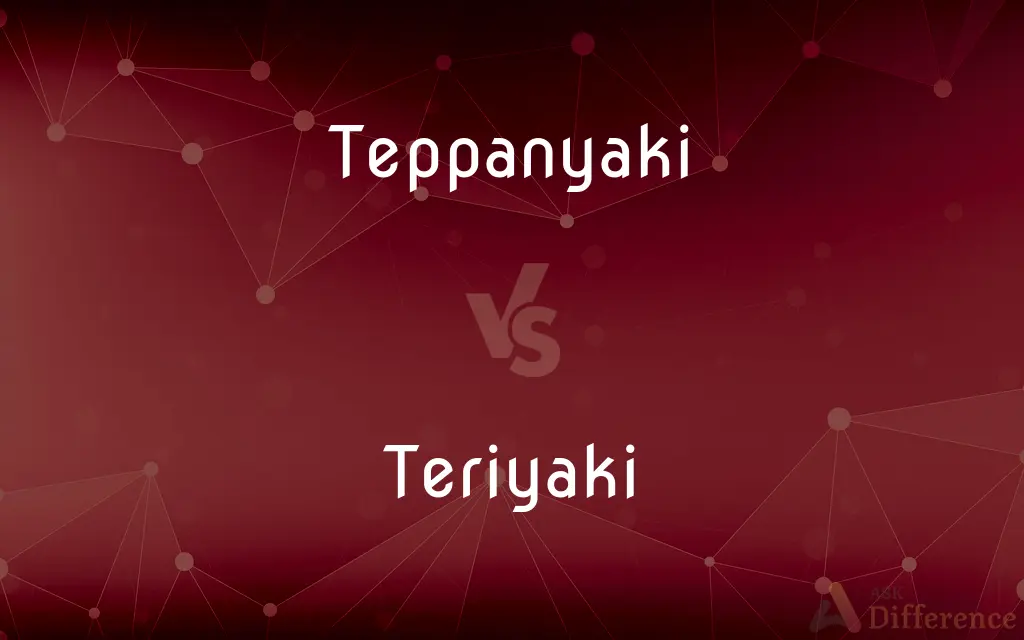Teppanyaki vs. Teriyaki — What's the Difference?
Edited by Tayyaba Rehman — By Maham Liaqat — Updated on April 20, 2024
Teppanyaki is a Japanese cooking style using an iron griddle for diverse ingredients, whereas teriyaki refers to a cooking technique featuring a glazed soy sauce marinade.

Difference Between Teppanyaki and Teriyaki
Table of Contents
ADVERTISEMENT
Key Differences
Teppanyaki involves cooking food on a large iron griddle, emphasizing interactive preparation often done in front of guests. Whereas teriyaki is a style where foods are marinated or brushed with a sweet soy sauce-based glaze and then grilled or broiled.
Teppanyaki chefs typically prepare a variety of meats, vegetables, and seafood directly on the griddle, showcasing their culinary skills through theatrical cooking methods. On the other hand, teriyaki dishes focus on the flavor imparted by the teriyaki sauce, which combines soy sauce, mirin, sugar, and sometimes sake.
The teppanyaki experience is also known for its social aspect, where diners sit around the griddle and interact with the chef and each other. Teriyaki, however, is usually prepared in the kitchen and served as a plated dish without the interactive element.
In teppanyaki, the emphasis is on the freshness and quality of the ingredients, as they are cooked minimally to enhance their natural flavors. In contrast, the appeal of teriyaki lies in the rich, caramelized coating of the sauce that flavors the ingredients.
Equipment plays a critical role in teppanyaki, requiring a large, flat griddle that allows chefs to cook multiple food items simultaneously and efficiently. Teriyaki cooking can be done on a standard grill or broiler, making it accessible for home cooking.
ADVERTISEMENT
Comparison Chart
Cooking Method
Cooked on an iron griddle
Grilled or broiled with a glaze
Main Ingredients
Various meats, vegetables, seafood
Typically chicken, beef, or fish
Sauce
No specific sauce, uses various
Soy sauce-based glaze
Dining Style
Interactive, communal
Typically served as a plated dish
Flavor Focus
Natural flavors of the ingredients
Flavor from the teriyaki sauce
Compare with Definitions
Teppanyaki
Known for its use of fresh, high-quality ingredients.
Our teppanyaki dinner featured freshly caught seafood and prime meats.
Teriyaki
A Japanese cooking technique involving foods marinated in a sweet glaze.
She served a delicious teriyaki chicken that she had marinated overnight.
Teppanyaki
A style of Japanese cuisine that uses an iron griddle to cook food.
The chef entertained us with his teppanyaki skills, flipping shrimp tails into his hat.
Teriyaki
Often used for chicken, beef, or fish dishes.
We ordered the teriyaki beef skewers, which were rich and flavorful.
Teppanyaki
Often involves cooking in front of the guests.
Teppanyaki chefs expertly chop and fry vegetables right at the table.
Teriyaki
Can be cooked on a grill or a broiler.
After marinating the fillets, he cooked them under the broiler for a quick teriyaki meal.
Teppanyaki
Typically includes a variety of meats and vegetables.
For our teppanyaki meal, the chef prepared both steak and scallops.
Teriyaki
Sauce made from soy sauce, mirin, and sugar.
The teriyaki sauce was homemade, adding a perfect glaze to the grilled salmon.
Teppanyaki
Cooking that combines performance art and culinary skill.
At the teppanyaki restaurant, we watched in awe as the chef created a flaming onion volcano.
Teriyaki
Emphasizes a sweet, savory flavor profile.
The teriyaki marinade gave the dish a delightful balance of sweet and savory notes.
Teppanyaki
Teppanyaki (鉄板焼き, teppan-yaki), also known in some countries as Hibachi (火鉢, "fire bowl"), is a post–World War II style of Japanese cuisine that uses an iron griddle to cook food. The word teppanyaki is derived from teppan (鉄板), the metal plate on which it is cooked on, and yaki (焼き), which means grilled, broiled, or pan-fried.
Teriyaki
Teriyaki (kanji: 照り焼き) is a cooking technique used in Japanese cuisine in which foods are broiled or grilled with a glaze of soy sauce, mirin, and sugar.Fish – yellowtail, marlin, skipjack tuna, salmon, trout, and mackerel – is mainly used in Japan, while white and red meat – chicken, pork, lamb, and beef – is more often used in the West. Other ingredients sometimes used in Japan include squid, hamburger steak, and meatballs.
Teppanyaki
A Japanese dish of meat, fish, or both, fried with vegetables on a hot steel plate forming the centre of the table
The restaurant has ten teppanyaki tables
Teriyaki
A Japanese dish of grilled or broiled slices of meat or seafood that have been marinated in a mixture of soy sauce, sugar or honey, garlic, ginger, and mirin.
Teppanyaki
A style of cooking in Japanese cuisine in which food, such as chopped beef, chicken, shrimp, or vegetables, is stir-fried on a griddle.
Teriyaki
The sauce used to marinate such a dish.
Teppanyaki
Food cooked in this way.
Teriyaki
A cooking technique used in Japanese cuisine in which foods are broiled or grilled in a sweet soy sauce marinade.
Teppanyaki
A Japanese style of cooking in which thin slices of meat, or fish, seafood, vegetables and noodles are quickly fried on a hotplate.
Teriyaki
A sweet soy sauce marinade.
Put some teriyaki on it.
Teriyaki
Beef or chicken or seafood marinated in spicy soy sauce and grilled or broiled
Common Curiosities
What types of foods are commonly cooked in teppanyaki?
Teppanyaki typically features a variety of foods including steak, shrimp, scallops, chicken, and assorted vegetables.
Can teriyaki dishes be considered healthy?
Teriyaki dishes can be healthy if made with lean meats and controlled portions of the sweet sauce, which is high in sugar.
What is the typical setting for a teppanyaki meal?
A typical teppanyaki meal is served at a large communal table with a built-in griddle, around which guests are seated.
Is teriyaki sauce available commercially?
Yes, teriyaki sauce is widely available in supermarkets, both in standard and gourmet varieties, as well as in gluten-free forms.
How do chefs entertain guests during a teppanyaki meal?
Teppanyaki chefs often perform tricks with their cooking utensils, make dramatic flames on the griddle, and interact playfully with guests.
What ingredients are necessary for making teriyaki sauce?
Basic teriyaki sauce includes soy sauce, mirin (a sweet rice wine), sugar, and sometimes sake.
What dietary restrictions can teppanyaki accommodate?
Teppanyaki can accommodate various dietary restrictions since the chef prepares food to order, allowing for the omission or substitution of ingredients.
What utensils are used for eating teppanyaki?
Teppanyaki is typically eaten with chopsticks, though some items might be easier to eat with a fork and knife depending on the setting.
Is teppanyaki suitable for vegetarians?
Yes, teppanyaki can be suitable for vegetarians by focusing on griddled vegetables and omitting meats.
Is it possible to prepare teriyaki-style dishes without a grill?
Yes, teriyaki dishes can be prepared in a skillet or broiled in an oven if a grill is not available.
How long does it take to marinade food in teriyaki sauce?
Marinating times for teriyaki sauce can range from 30 minutes for quick-cooking items like fish, up to several hours for deeper flavor in meats like chicken and beef.
How does teppanyaki differ from other Japanese cuisines like sushi?
Unlike sushi, which involves raw fish and vinegared rice, teppanyaki is all about grilled foods and does not typically include raw elements.
Can teriyaki be used as a dipping sauce?
Yes, teriyaki sauce can also be used as a dipping sauce for cooked meats, sushi, or even dumplings.
What are some common side dishes served with teppanyaki?
Common side dishes for teppanyaki include miso soup, steamed rice, and various pickled vegetables.
How can I make a simple teriyaki sauce at home?
A simple homemade teriyaki sauce can be made by mixing equal parts soy sauce and mirin with a smaller amount of sugar, heating it until the sugar dissolves and the sauce thickens slightly.
Share Your Discovery

Previous Comparison
Graphene vs. Graphite
Next Comparison
Jamb vs. JamAuthor Spotlight
Written by
Maham LiaqatEdited by
Tayyaba RehmanTayyaba Rehman is a distinguished writer, currently serving as a primary contributor to askdifference.com. As a researcher in semantics and etymology, Tayyaba's passion for the complexity of languages and their distinctions has found a perfect home on the platform. Tayyaba delves into the intricacies of language, distinguishing between commonly confused words and phrases, thereby providing clarity for readers worldwide.














































